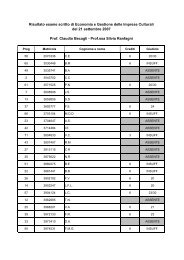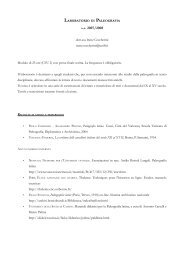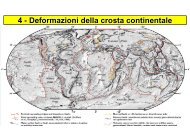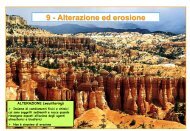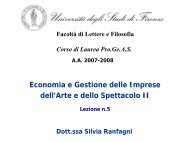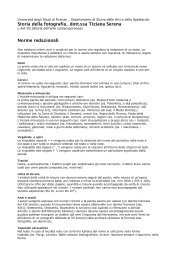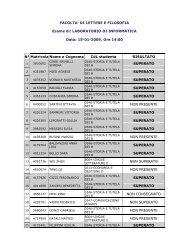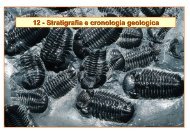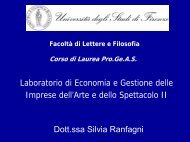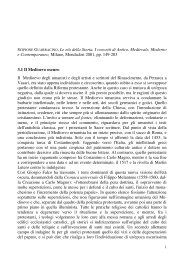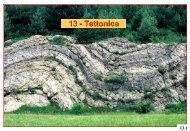Beyond Pragmatics. Morphosyntactic Development in Autism.pdf
Beyond Pragmatics. Morphosyntactic Development in Autism.pdf
Beyond Pragmatics. Morphosyntactic Development in Autism.pdf
Create successful ePaper yourself
Turn your PDF publications into a flip-book with our unique Google optimized e-Paper software.
J <strong>Autism</strong> Dev Disord<br />
across participants with autism, <strong>in</strong>dependent of<br />
functional level, consistent with least one large study<br />
of language profiles <strong>in</strong> autism (Jarrold et al., 1997).<br />
Furthermore, the focus <strong>in</strong> this study was on identify<strong>in</strong>g<br />
deficits that characterized children with autism<br />
as a group, and, due to the labor-<strong>in</strong>tensive language<br />
analyses employed, numbers of participants were<br />
<strong>in</strong>sufficient to conclusively determ<strong>in</strong>e the presence of<br />
coherent subgroups. Further study is needed to<br />
address these issues.<br />
F<strong>in</strong>ally, the present study shares a limitation with<br />
much of the research on language <strong>in</strong> autism: the challenge<br />
of choos<strong>in</strong>g appropriate match<strong>in</strong>g criteria.<br />
Match<strong>in</strong>g on the PPVT-III raises a concern that the<br />
identification of objects <strong>in</strong> a PPVT-style task may be a<br />
peak of ability <strong>in</strong> high function<strong>in</strong>g <strong>in</strong>dividuals on the<br />
autism spectrum, that serves to over-estimate IQ<br />
(Mottron, 2004). In this study, non-verbal IQ served as<br />
the primary match<strong>in</strong>g criterion, and groups were also<br />
matched on PPVT-III receptive vocabulary to ma<strong>in</strong>ta<strong>in</strong><br />
consistency with the large literature also match<strong>in</strong>g<br />
on that basis. In addition, only participants who were<br />
comb<strong>in</strong><strong>in</strong>g words <strong>in</strong>to 2-word phrases were <strong>in</strong>cluded, <strong>in</strong><br />
order to <strong>in</strong>sure that all participants had at least begun<br />
to communicate verbally. To address this limitation <strong>in</strong><br />
the match<strong>in</strong>g procedure, analyses were performed both<br />
with and without the PPVT-III results covaried , with<br />
no change <strong>in</strong> results.<br />
The major f<strong>in</strong>d<strong>in</strong>g of the present study is that children<br />
with autism, compared with chronological age-<br />
(DD group) and non-verbal mental age- (DD and TD<br />
groups) matched peers exhibited clear delays <strong>in</strong> syntactic<br />
knowledge. In contrast to these syntactic<br />
impairments, the autism group’s lexical knowledge was<br />
unimpaired. We have discussed some possible factors<br />
underly<strong>in</strong>g these syntactic impairments, <strong>in</strong>clud<strong>in</strong>g the<br />
production of jargon, the discussion of less complex<br />
events <strong>in</strong> the world, and the atypical sequence of<br />
learn<strong>in</strong>g of syntactic structures. One important implication<br />
is that receptive vocabulary abilities, such as<br />
those measured by the PPVT-III, are likely an <strong>in</strong>adequate<br />
marker of ‘‘language ability,’’ and studies that<br />
match groups based only on lexical measures are likely<br />
to overestimate the comprehension of children <strong>in</strong> the<br />
autism group.<br />
Acknowledgement This research was supported by the NIMH<br />
(R03 grant # MH61032-01), a Young Investigator award from the<br />
Journal of Language Learn<strong>in</strong>g, and a Dissertation Award from<br />
the Society for Science of Cl<strong>in</strong>ical Psychology, to IME. We are<br />
especially grateful to the parents and children that participated<br />
<strong>in</strong> the study.<br />
Appendix Index of Productive Syntax (IPSyn) Items<br />
Table 7<br />
Verb phrases subscale<br />
Sentence structures<br />
subscale<br />
Verb<br />
Two-word comb<strong>in</strong>ation<br />
Particle or preposition<br />
Subject-verb sequence<br />
Prepositional phrase<br />
Verb-object sequence<br />
(Preposition + NP)<br />
Copula l<strong>in</strong>k<strong>in</strong>g two nom<strong>in</strong>als Subject-verb-object<br />
sequence<br />
Catenative (pseudo-auxiliary) Conjunction (any)<br />
preced<strong>in</strong>g a verb<br />
Auxiliary be, do, have <strong>in</strong> VP Sentence with two VPs<br />
Progressive Suffix<br />
Conjo<strong>in</strong>ed phrases<br />
Adverb<br />
Inf<strong>in</strong>itive marked with to<br />
Modal preced<strong>in</strong>g verb<br />
Let/Make/Help/Watch<br />
<strong>in</strong>troducer<br />
Third person s<strong>in</strong>gular present Adverbial conjunction<br />
tense suffix<br />
Past tense modal<br />
Propositional complement<br />
Regular past tense suffix Conjo<strong>in</strong>ed sentences<br />
Past tense auxiliary<br />
Wh- clause<br />
Medial adverb<br />
Bitransitive predicate<br />
Copula, modal, or auxiliary Sentence with 3 or<br />
for emphasis or ellipsis<br />
more VP’s<br />
(non-contractible context)<br />
Past tense copula<br />
Relative clause, marked<br />
or unmarked<br />
Bound morpheme on verb Inf<strong>in</strong>itive clause with<br />
or on adjective<br />
new subject<br />
Gerund<br />
Fronted, center-embedded<br />
subord. clause<br />
Passive construction<br />
Question-Negation Subscale Noun Phrases Subscale<br />
Intonationally marked question Proper, mass, or<br />
count noun<br />
Rout<strong>in</strong>e do/go, existence Pronoun or prolocative<br />
question, wh- pronoun<br />
(not modifier)<br />
Negation (no(t), can’t, don’t) + Modifier (adjective,<br />
X (NP, VP, PP)<br />
possessive, quantifier<br />
Initial wh- pronoun followed 2-word NP: Article/<br />
by verb<br />
modifier + nom<strong>in</strong>al<br />
Negative morpheme between Article, used before a noun<br />
subject and verb<br />
Wh- question- <strong>in</strong>verted modal, Two-word NP after verb<br />
copula, auxiliary<br />
or preposition<br />
Negation of copula, modal, Plural suffix<br />
or auxiliary<br />
Yes/no question- <strong>in</strong>verted modal, 2-word NP (as N4)<br />
copula, auxiliary<br />
before verb<br />
Why, When, Which, Whose 3-word NP (Determ<strong>in</strong>er +<br />
Modifier + Noun)<br />
Tag question<br />
Adverb modify<strong>in</strong>g adjective<br />
or nom<strong>in</strong>al<br />
Questions with negation + Any bound morpheme on<br />
<strong>in</strong>verted copula, modal<br />
noun, adjective<br />
Note: NP = noun phrase, VP = verb phrase, PP = prepositional<br />
phrase<br />
123


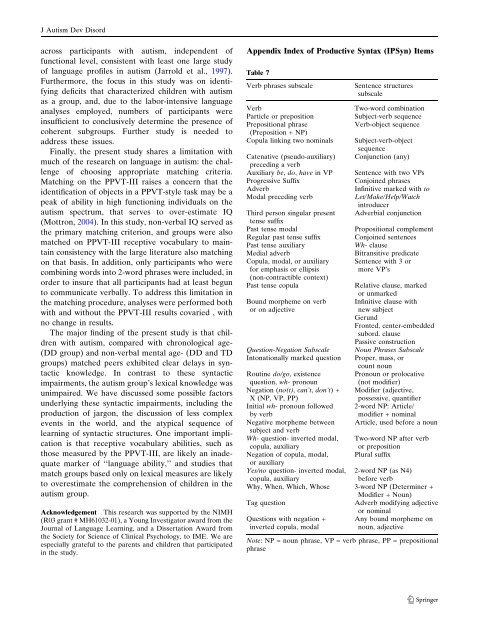
![PATROLOGIA GRECA E LATINA [Patrologiae cursus completus]. All ...](https://img.yumpu.com/50711133/1/184x260/patrologia-greca-e-latina-patrologiae-cursus-completus-all-.jpg?quality=85)
